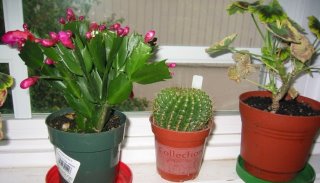
Some green therapy here. Each year I seem to find something different to over-do. One year it was roses, then tomatoes, then peppers, then figs. The roses are mostly still there, but out of favor due to high maintenance (except a few). I can only grow so many tomatoes or figs, and I think i have them more-or-less figured out for this area. The peppers are not so rewarding although I'll keep trying a few.
Without intending to, it looks like this time it's cacti. Looking around the yard and in the windows, there are quite a few. These are not well identified, but I'm thinking (left to right) Echinopsis sp, Gymnocalycium sp., and Selenocereus sp. These identifications may change if they have identifiable blossoms. Based on web photos, Gymnocalycium flowers are amazingly colorful.

I've been growing this cactus through about 4 'cutting generations' over a period of 15 years. It sits neglected in the yard in the summer, and occasionally I start a new pad. I've given away some of the larger plants due to moving, and one was killed in a frost. Now I want to try again. based on photos in a book and on the web, this is Opuntia neoargentina but could also go by Brasioliopuntia braziliensis and multiple other names. It has a yellow flower. It can grow as a tree on a thick trunk, and tiers of branches with pads that fall off when dry. The original was a gift from a friend in Lafayette indiana; his cactus was over 6 feet tall when I first saw it. Googling on this species, it appears to be threatened in its original habitat in much of its habitat, much of which has been destroyed in Brazil, but it also grows widely in some tropical areas.

Today 2 more were added from Lowes. The result of an overly stressful week (if only I drank, I wouldnt have to keep adding vegetation around the house!). Given the winter season, a colorful Schlumbergera hybrid (labeled as Zygocactus) and a small Parodia (labeled as Notocactus herteri). The Notocactus comes in many colorful varieties.
Outside are 2 Opuntias that have survived two winters so far. Neither has blooded.
It's amazing to look at the photos of cactus flowers and read about their climates, and the history of their horticulture.

No comments:
Post a Comment
Note: Only a member of this blog may post a comment.